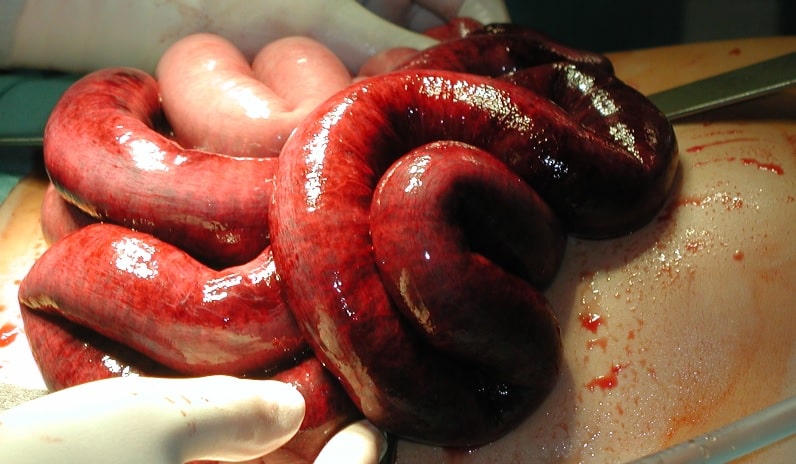Introduction
Acute mesenteric ischaemia is the sudden decrease in the blood supply to the bowel, resulting in bowel ischaemia and necrosis. If not identified and promptly treated will rapidly lead to death.
The common causes of acute mesenteric ischaemia can be classified into:
- Thrombus-in-situ (Acute Mesenteric Arterial Thrombosis, AMAT)
- Embolism (Acute Mesenteric Arterial Embolism, AMAE)
- Non-occlusive cause (Non-Occlusive Mesenteric Ischemia, NOMI)
- Venous occlusion and congestion (Mesenteric Venous Thrombosis, MVT)
Rarer causes for acute mesenteric ischaemia include Takayasu’s arteritis, fibromuscular dysplasia, polyarteritis nodosa, and thoracic aortic dissection.
| Type | Proportion of Cases | Underlying Cause |
| AMAT | 25% | Atherosclerosis |
| AMAE | 50% | Cardiac causes* or thoraco-abdominal aneurysm |
| NOMI | 20% | Hypovolaemic shock, cardiogenic shock |
| MVT | <10% | Coagulopathy, malignancy, autoimmune disorders |
*Cardiac causes include arrhythmias (e.g. atrial fibrillation), post-MI mural thrombus, or prosthetic heart valve
In this article, we shall look at the causes, clinical features and management of a patient with acute mesenteric ischaemia.
Risk Factors
The risk factors for acute mesenteric ischaemia depend on the underlying cause.
Specifically, however for AMAE, the main reversible risk factors are smoking, hyperlipidaemia, and hypertension, much the same as for chronic mesenteric ischaemia.
Clinical Features
Traditionally, mesenteric ischaemia presents with a generalised abdominal pain that is out of proportion to the clinical findings, although it can often be more variable or subtle than this. The patient will typically complain of a diffuse and constant pain, with associated nausea and vomiting in around 75% of cases.
Abdominal examination will often reveal non-specific tenderness*, with no specific clinical signs. In later stages (especially if the bowel has perforated), patients will have features of globalised peritonism.
Importantly, take note of any potential embolic sources, such as atrial fibrillation or heart murmurs, that may provide a suggestion to the underlying cause
Differential Diagnosis
Mesenteric ischaemia should always be considered in cases of the acute abdomen, especially where there is no other obvious cause. Other causes of acute abdomen that may have similar presentations include peptic ulcer disease, bowel perforation, and symptomatic abdominal aortic aneurysm
Investigations
Laboratory Tests
An arterial blood gas (ABG) should be performed urgently, to assess the degree of acidosis and serum lactate, secondary to the severity of bowel infarction (however these can be normal, even in severe cases).
Routine blood tests that should be performed, including FBC, U&Es, clotting (especially if patient anti-coagulated), amylase*, and LFTs (if the coeliac trunk is affected, ischaemia of the liver may cause derangement), as well as a group and save.
*Whilst an amylase is commonly measured to exclude pancreatitis as a cause of the abdominal pain, counter-intuitively amylase also rises in mesenteric ischaemia, as well as ectopic pregnancy, bowel perforation, and diabetic ketoacidosis.
Imaging
The definitive diagnosis of acute mesenteric ischaemia, for both arterial and venous mesenteric disease, requires a CT scan with intravenous contrast, both in arterial (angiogram) and portal venous phase.
Arterial bowel ischaemia will initially show on CT imaging as oedematous bowel, secondary to the ischaemia and vasodilatation, before progressing to a loss of bowel wall enhancement* and then to pneumatosis. In addition, the CT scan should highlight an acute occlusion of typically the superior mesenteric artery or coeliac artery with a halo sign around the occlusion.
*Oral contrast should be avoided in cases of mesenteric ischaemia due to difficulty in assessing for bowel wall enhancement
Management
Initial Management
Acute mesenteric ischaemia is a surgical emergency, requiring urgent resuscitation with early senior involvement.
Ensure the patient receives intravenous fluids, a urinary catheter inserted, and a fluid balance chart started. For confirmed cases, broad-spectrum antibiotics should be given, due to the risk of faecal contamination in case of perforation of the ischaemic (and potentially necrotic) bowel and bacterial translocation.
The patient will have a significant acidosis and is at high risk of developing multi-organ failure, therefore early ITU input to optimise the patient and for post-operative support is necessary.
Definitive Management
The location, timing, and severity of the mesenteric ischaemia, among other factors, will determine the surgical intervention performed:
- Excision of necrotic or non-viable bowel, if not suitable for (or able to access) revascularisation
- Post-operatively the patient should be on the intensive care unit, planned for potential relook laparotomy in 24-48 hours; the majority of patients will end up with either covering loop or end stoma and there is a high chance of short gut syndrome.
- Revascularisation of the bowel, involving removal of any thrombus or embolism via radiological intervention, either suction thrombectomy or thrombolysis; the decision for revascularisation is made depending upon the state of the patient, the bowel, and the angiographic appearance of the mesenteric vessels.
- This is preferably done through interventional radiology technique due to the risk of aortic contamination in open surgery, however open embolectomy is possible either through the coeliac trunk, SMA, IMA, or the aorta.
- Venous ischaemia is typically managed in the same manner, however anticoagulation and bowel resection where required are the mainstay of management
Complications
The main risks from mesenteric ischaemia are bowel necrosis and perforation. The mortality from the condition can be >50% in certain patient groups, even if the diagnosis is made and treatment performed promptly. Those that survive may have short gut syndrome if a significant amount of bowel needs to be resection
Key Points
- Acute mesenteric ischaemia is most commonly caused by an embolus, yet may also be caused by a thrombus-in-situ, venous occlusion, or non-occlusive causes
- Patients present with excessive pain, out of proportion to clinical findings with typically an otherwise unremarkable examination
- Ensure to assess for potential sources of embolus
- Definitive diagnosis is made via CT angiography
- Surgical treatment involves either bowel resection or revascularisation, however mortality rates are >50% even in treated cases


